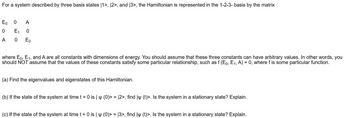Related questions
Question
can you solve these and write the problems out please, not typing

Transcribed Image Text:For a system described by three basis states [1>, 12>, and 13>, the Hamiltonian is represented in the 1-2-3-basis by the matrix
Eo
0 A
0
E₁
A 0
0
Eo
where E0, E1, and A are all constants with dimensions of energy. You should assume that these three constants can have arbitrary values. In other words, you
should NOT assume that the values of these constants satisfy some particular relationship, such as f (Eo, E₁, A) = 0, where f is some particular function.
(a) Find the eigenvalues and eigenstates of this Hamiltonian.
(b) If the state of the system at time t = 0 is | (0)> = [2>, find | (t)>. Is the system in a stationary state? Explain.
(c) If the state of the system at time t = 0 is | (0)>= 13>, find ly (t)>. Is the system in a stationary state? Explain.
Expert Solution
This question has been solved!
Explore an expertly crafted, step-by-step solution for a thorough understanding of key concepts.
Step by stepSolved in 2 steps with 2 images
